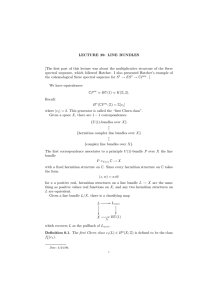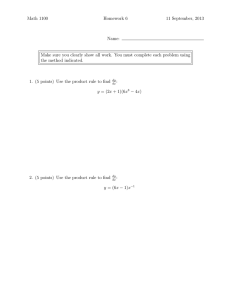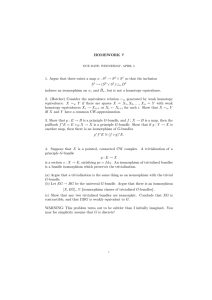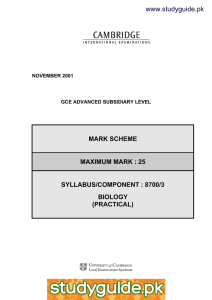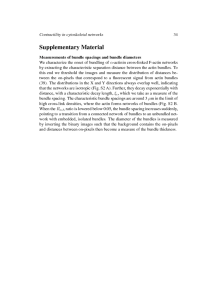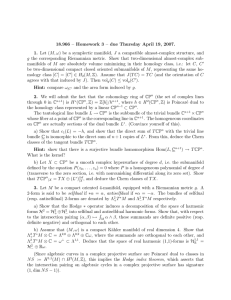LECTURE 30: INDUCED MAPS BETWEEN ... SPACES, H (BU (n))
advertisement
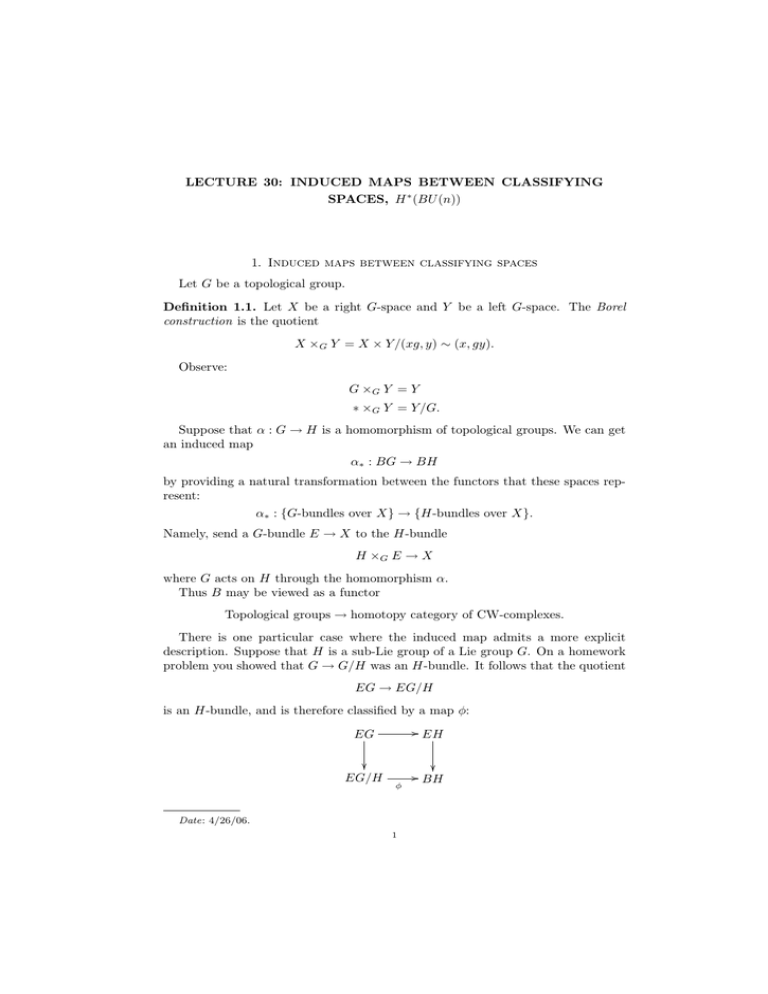
LECTURE 30: INDUCED MAPS BETWEEN CLASSIFYING
SPACES, H ∗ (BU (n))
1. Induced maps between classifying spaces
Let G be a topological group.
Definition 1.1. Let X be a right G­space and Y be a left G­space. The Borel
construction is the quotient
X ×G Y = X × Y /(xg, y) ∼ (x, gy).
Observe:
G ×G Y = Y
∗ ×G Y = Y /G.
Suppose that α : G → H is a homomorphism of topological groups. We can get
an induced map
α∗ : BG → BH
by providing a natural transformation between the functors that these spaces rep­
resent:
α∗ : {G­bundles over X} → {H­bundles over X}.
Namely, send a G­bundle E → X to the H­bundle
H ×G E → X
where G acts on H through the homomorphism α.
Thus B may be viewed as a functor
Topological groups → homotopy category of CW­complexes.
There is one particular case where the induced map admits a more explicit
description. Suppose that H is a sub­Lie group of a Lie group G. On a homework
problem you showed that G → G/H was an H­bundle. It follows that the quotient
EG → EG/H
is an H­bundle, and is therefore classified by a map φ:
/ EH
EG
EG/H
φ
Date: 4/26/06.
1
/ BH
Proposition 1.2. The map φ is an equivalence, and the map induced by the
inclusion
i : H �→ G
is the quotient map
i∗ : BH � EG/H → EG/G = BG.
A proof of this proposition is deferred to the next lecture.
Corollary 1.3. There is a fiber sequence
i
∗
G/H → BH −→
BG.
2. Classifying vector bundles
Given a paracompact space X, there are 1 − 1 correspondences
{U (n)­bundles over X}
�
{hermitian n­dimensional complex vector bundles over X}
�
{n­dimensional complex vector bundles over X}.
The first correspondence associates to a principle U (n)­bundle P over X the vector
bundle
P ×U (n) Cn → X
with a fixed hermitian structure on Cn .
Using partitions of unity, every vector bundle admits a hermitian structure,
unique up to isomorphism.
3. Calculation of H ∗ (BU (n))
Theorem 3.1. There is an isomorphism
H ∗ (BU (n); Z) ∼
= Z[c1 , . . . , cn ].
The generator ci lies in degree 2i, and is called the ith Chern class. The induced
map
H ∗ (BU (n)) → H ∗ (BU (n − 1))
is the quotient by the ideal (cn ).
Proof. We prove this theorem by induction on n, using the Serre spectral sequence
of the fiber sequence
S 2n−1 → BU (n − 1) → BU (n).
The E2 ­term takes the form
E2∗,∗ = H ∗ (BU (n)) ⊗ Λ[e2n−1 ]
where H s (BU (n)) lies in E2s,0 and |e2n−1 | = (0, 2n − 1). Because this is a 2­
line spectral sequence, the only possible non­trivial differential is d2n , and the
spectral sequence degenerates into a long exact sequence (the Gysin sequence).
Because the inductive hypothesis implies that H ∗ (BU (n − 1)) is concentrated in
2
even dimensions, we may deduce that the differential d2n (e2n−1 ) is non­trivial, and
we define cn ∈ H n (BU (n)) to be the image of this differential
cn := d2n (e2n−1 ).
The multiplicative structure implies that d2n is given by cupping with cn . Thus
the E∞ ­term is comprised of the elements of H ∗ (BU (n)) annihilated by cn , and
the quotient of H ∗ (BU (n)) by the ideal (cn ). By inducting over k, using the
fact that H ∗ (BU (n − 1)) is concentrated in even dimensions, we can argue that
H k (BU (n)) must be generated in even dimensions, implying that in fact there can
be no elements annihilated by cn . Thus H ∗ (BU (n)) is generated by c1 , . . . , cn , with
H ∗ (BU (n))/(cn ) = Z[c1 , . . . , cn−1 ].
We deduce that there is an isomorphism H ∗ (BU (n)) ∼
= Z[c1 , . . . , cn ].
3
�
